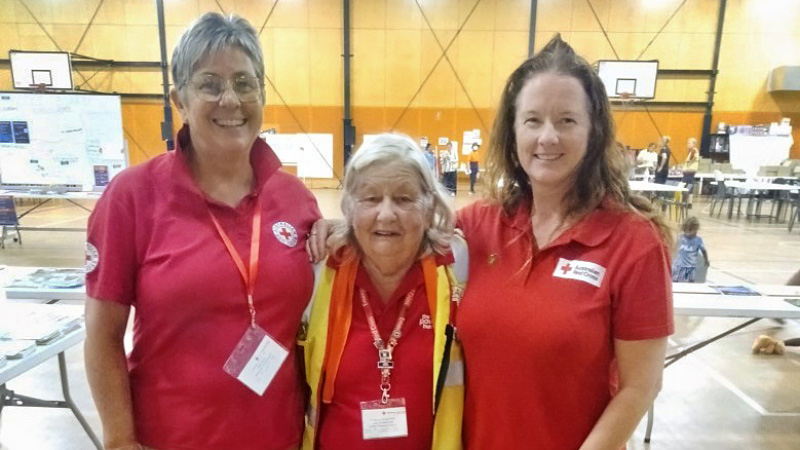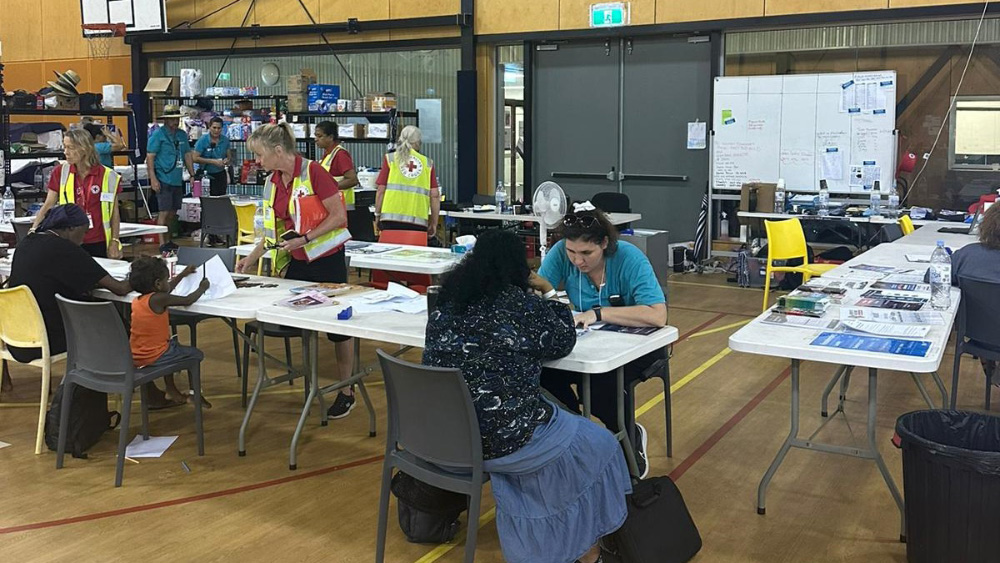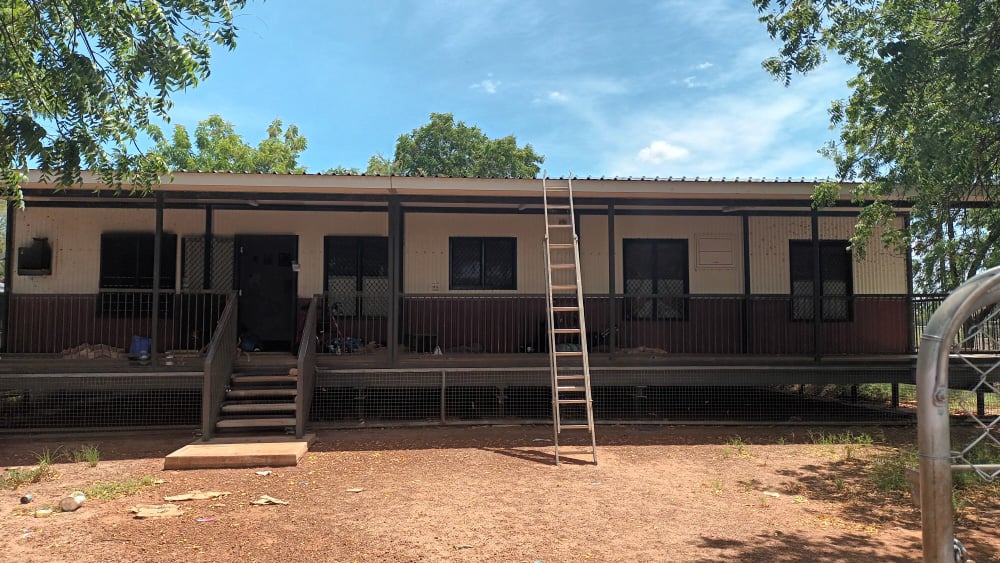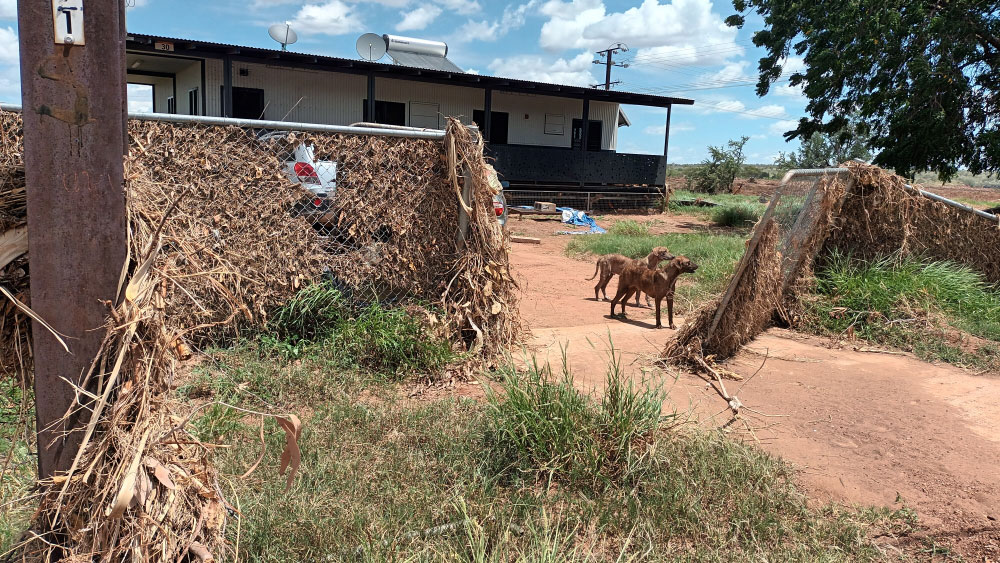Northern Territory floods: recovery will be long and complex
Emergency services
Northern Territory floods: recovery will be long and complex
When three remote First Nations communities were evacuated, Red Cross teams were on hand to help – support that continues as people return home.
The Royal Australian Air Force helps residents from Kalkarindji evacuate during major flooding in the Northern Territory. Photo: Department of Defence/CPL Ashley Gillett
When floods swept through the tiny community of Daguragu in the Northern Territory, everyone crowded onto the roof of one house.
As the rain thundered down and water poured into their homes, together they waited, hoping to be rescued.
“About 230 people live in Daguragu. They told me how the water chased them up the street. It was a traumatic experience,” says Annette Plowman, Red Cross Emergency Services Manager for the Northern Territory.
“At dawn, the rescue helicopters came but couldn’t land. People described how they were airlifted to safety one by one. Grandfathers told stories of pilots saying, ‘You’ve three grandkids, but we can’t take them all at once. Which two do you want us to take?’” she says.
“By the time rescue came, they had run out of food; they were hungry, tired, frightened and exhausted.”
Three small, remote First Nations communities – Daguragu, Kalkarindji and Nitjpurru – were evacuated by air when floods hit the Big Rivers region in February. For almost three months, Red Cross teams supported hundreds of people at the Howard Springs evacuation centre near Darwin and continued to help after their return home.
Human connection in a crisis
"That first night, people arrived at 11.30pm. On other days it was 2.30am. Transport was difficult because of the weather. Some people were flown to Katherine and then bused to Darwin – another four-hour trip. Some were wet, tired, and hungry but happy to be safe."
Red Cross staff and volunteers managed the evacuation centre 24 hours a day, greeting everyone as they arrived. Trained in psychosocial first aid, our teams support people coping with a crisis. In a disaster, people can feel frightened, teary, despondent, and sometimes even angry as they try to come to terms with what has happened.

“Our support is all about human connection, sitting and listening to people, asking if they are okay. They might say, 'Yes, but I'd love a cup of tea'. Or they might say, 'Actually, I'm really not okay.'”
People were worried about the damage to their homes and community, the environmental impacts of the floods, and the animals they had to leave behind. They were also anxious about when they would be able to return, says Annette.
"We helped comfort and reassure people, working with them to figure out what they needed. It's about self-efficacy, too. It's a great feeling watching people regain their power in a challenging, stressful situation.
“People felt safe sharing their stories with us. And I see us as a conduit between the communities we support and agencies who can help. We link them with any extra help they need, maybe counselling, financial support, or even replacing identity documents lost when they evacuated.
“That first Friday after the evacuations began, I was driving home and exhausted. But I remember thinking, ‘There are 528 people sleeping in beds in the centre tonight. They are safe. We did that, and it’s pretty special.’”
When nothing seems normal
With the communities inaccessible, it was weeks before agencies could assess the scale of the damage. That meant for a long-time people didn’t know when they would be able to go home, she says.
"Living in an evacuation centre is not easy and is usually a short-term solution. You're sharing a confined space with lots of others. You don't get to choose your family's living arrangements or what you eat. There's a lot of noise, a lack of autonomy, and boredom."
Even the physical environment was so different to what people were used to, Annette says. "I can only imagine the feeling of confusion and displacement. Their homes are nearly 12 hours drive from Darwin, so the buildings, the traffic and the weather were unfamiliar.
“I remember when the kids saw the sand on the evacuation centre's volleyball court and asked what it was. We told them it was beach sand, and they were like, 'What's that?'
“We did everything we could to bring normal to a very unnormal environment.
"Working with other organisations, a play group, a health clinic, children and family services, and aged care services were set up at the evacuation centre. Back home, they had all these services, which employed many people in the community. We also had schoolteachers, the Night Patrol, and an employment program so people could get their tickets for truck driving.”
Red Cross teams worked with community leaders and Elders to ensure they had a say in decision-making and the centre’s operation. At the peak, almost 768 people were sheltering at Howard Springs, 268 of them children.

Leading from the heart
Annette has worked alongside Aboriginal Torres Strait Islander people in the territory for over 20 years. “In my experience, everything is led by the heart. And though we hadn't worked with these three communities before, from our actions, they understood we were neutral and independent and were just there to help.
“We didn’t need to tell them; they knew we were there for them and to elevate their voices.
"There was one older woman who would gently touch my arm every time we passed each other. She didn't speak, but I felt she was letting me know we were doing a good job. One day she gave me the warmest hug and the warmest smile. That captured everything I felt in a single moment."
When the floodwaters receded and it was safe, Annette and local leaders visited the communities to assess the damage. The trips were organised so the leaders could take back firsthand reports to help people prepare for returning home.
“In Daguragu, they pointed out the roof where they’d waited to be rescued. One man described how he walked through waist-deep water to get a ladder, how they helped people onto the roof, the elderly and a young boy who was disabled. The ladder was still there, leaning against the house.

“As we walked around the community, I saw bags of clothes on people’s roofs. And then I saw a little blue car in the middle of the road. That same man said it was his: ‘That’s as far as I could drive it. When I realised no one was coming to help, I started picking people up. Someone had to do something.’
In the evacuation centre, they'd heard many stories of the heroic rescue efforts of community members, says Annette.
In Nitjpurru, she saw where the water had reached the roofs of homes and grass tangled in fences and washing lines. “Before I went, the community said, ‘There are 11 dogs. You’ve got to make sure they’re all there.’ Food had been airdropped for them, but some hadn’t survived. As we flew out, the dogs that were left howled. It was awful.”

Returning to country
On March 27, more than three weeks after the evacuations, the staggered repatriation of communities began. “People were feeling a mix of emotions. Some wanted to get back onto country. Others were worried about what they would find, the damage to their homes and what that would mean if they couldn't be repaired.
"The community of Daguragu had told me about the beauty of their land and its big trees. When I visited, those trees were all gone. The floods had taken them, like those road diggers that tear up bitumen.”
The evacuation centre closed in early May, two months after it opened. The people of Daguragu and Kalkarindji returned home, though many families are in temporary shelters. But Nitjpurru was still inaccessible. Its 110 or so residents were temporarily relocated to another remote community where they lived in tents. They finally returned home in late July.
Red Cross outreach teams have been visiting communities. Annette says they checked how people were coping and what support they needed. "Recovery will be a long and complex process. It's not over when belongings have been replaced and homes and infrastructure repaired. The psychosocial effects of disasters can last for years.
“We know from our experience in other disasters that recovery can take three to five years or even longer. We know, too, that supporting people with their recovery is also about helping them build greater resilience for the future.”
Where to from here?
These isolated communities have been through an incredibly challenging and traumatic experience, says Annette. "And there are so many levels in what their recovery looks like. Community members spoke of ongoing challenges around land rights and tenure connecting back to floods more than two decades ago. These are unique communities.”
One Elder explained to her how much their land had changed since the 1950s.
"He said, ‘There’s no future for us here. We have to move. Those hills hold water now. It spins around like a whirlpool, and it’s eroding the land. This is climate change. We need to talk about the future of this community.’”
As the climate crisis unfolds, our teams are responding to extreme weather events with increasing frequency. Over the last financial year, we helped over 45,800 people affected by 33 disasters and emergencies in Australia.
Thanks to our generous supporters, Red Cross emergency response teams can be ready to help 24/7, 365 days a year.
By being equipped and prepared in advance, we can minimise people’s suffering and provide essential emotional and practical support in the crucial hours and days when it matters most.